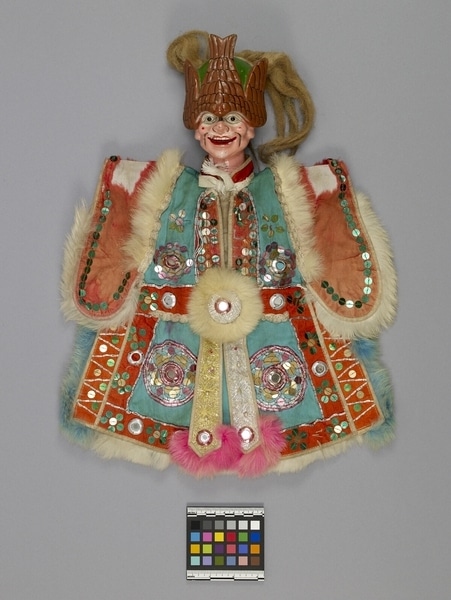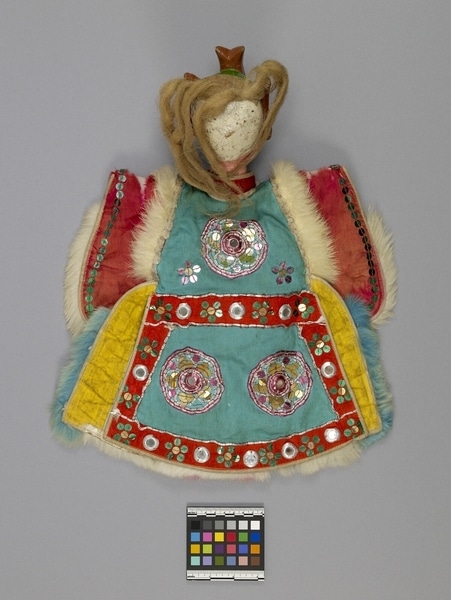Hand Puppet Item Number: Ia61 a-b from the MOA: University of British Columbia




Description
Male character in Daoist robe, Golden Rays style. Costumed, cloth hand puppet with carved, painted wooden head, hands, and feet. Forehead is green, back of head and eye areas are white, face and neck are pink, bird headdress is brown with black outlines suggesting feathers, red mouth is wide open, red dots on cheeks. Tan dyed hair, glued across top of head. Body (part a) is undyed cotton flaps, attaching around head, with attached white/cream hands with holes through sideways, partially stuffed with paper, stuffed legs, white and green soled black boots. Pasted and stitched blue silk, cotton lined robe (part b); sleeves pink/orange with orange borders and collar; blue, white, yellow and pink fur trim. Flower-like decorations, in foil wrapped thread, plastic sequins and tin edged mirrors. Yellow and white brocade trim at centre, backed with character printed paper. Costume is detachable, tied with cord at neck.
History Of Use
Chinese hand puppet theatre continues to be an active form of popular entertainment in Taiwan. In general, it has a long (over 2,000 years) history which reached a peak of activity during the Qing Dynasty. By then Fukinese hand puppet theatre had reached Taiwan and by 1900, five hundred troupes were touring the island, playing during seasonal festivals, religious celebrations, birthdays, weddings and banquets. Traditionally, 7 men made up a troupe, 2 to manipulate the puppets and speak the roles, and 5 musicians to provide accompaniment and sound effects. Plots are adapted from novels, fairy and folk tales, history and from supernatural events. Short comic scenes opened the presentation, followed by long plays. By 1900, in Taiwan, puppet theatre began taking on distinctive Taiwanese traits, and after the outbreak of the Sino-Japanese War, Fukinese puppets were no longer imported. Puppets became larger (closer to 50 cm) and less finely carved. Costumes are patterned on Ming Dynasty (1368-1644) dress, and the iconographic style often follows Chinese opera.
Cultural Context
Used in puppet theatre performances.
Iconographic Meaning
Since the true nature of supernatural beings are expressed on the headdress (ucla), a bird-like being may be represented.
Item History
- Made in Taiwan before 1950
- Owned by Dorian Rae before October 31, 1980
- Received from Museum of Anthropology Shop Volunteers (Funding source) and Dorian Rae (Seller) on October 31, 1980
What
Who
- Culture
- Taiwanese
- Previous Owner
- Dorian Rae
- Received from
- Museum of Anthropology Shop Volunteers (Funding source) and Dorian Rae (Seller)
Where
- Holding Institution
- MOA: University of British Columbia
- Made in
- Taiwan
When
- Creation Date
- before 1950
- Ownership Date
- before October 31, 1980
- Acquisition Date
- on October 31, 1980
Other
- Condition
- fair
- Accession Number
- 0677/0005